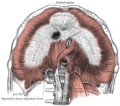Lumbocostal triangle
From Wikipedia, the free encyclopedia
| Lumbocostal triangle | |
|---|---|
 | |
| The diaphragm. Under surface. (Lumbocostal triangle not labeled, but costal and lumbar regions are visible.) | |
 | |
| With captions (labels in German.) | |
| Latin | trigonum lumbocostale |
| Gray's | subject #117 406 |
The Lumbocostal triangle or Bochdalek's foramen is a defect in the diaphragm normally posterior lateral. It is formed by the incomplete closure of the pericardioperitoneal canals by the pleuroperitoneal membrane.
Clinical significance
The existence of this foramen might cause a congenital diaphragmatic hernia, Bochdalek hernia.
This condition has also been associated with thoracic kidney, the presence of the kidney in the thorax instead of the usual abdominal position.[1]
References
- ↑ Doi, Y, Sakamoto A (2009) "Thoracic Kidney", New Engl J Med 361:e35. Thoracic Kidney
External links
| |||||||||||||||||||||||
This article is issued from Wikipedia. The text is available under the Creative Commons Attribution/Share Alike; additional terms may apply for the media files.